Electro-Optical Sampling
To clearly set and properly tune the distance between bunches in a totally not intercepting way we used EOS (Electro-Optical Sampling) with spatial decoding. The EOS provides the possibility of measuring the longitudinal charge distribution by means of nonlinear crystals placed near the moving electron beams and it can reach high temporal resolutions, determined by the width of the optical laser pulse and the EO crystal length. The working principle is based on the induced birefringence in a nonlinear crystal (like ZnTe and GaP) by the high electric fields of the relativistic electron bunch, which propagate in the crystal like a THz-field. Since the crystal becomes anisotropic (biaxial), the electric field of a polarized laser passing in the crystal is decomposed along the two optical axes, with characteristic refractive indices Because the two components travel at different velocities, at the end of the crystal their relative phase delay is a measurement of the longitudinal electric field.
We implement EOS in very different scenarios for different purposes.
At SPARC_LAB we used for the first time to measure the distance between pulses in a Comb Beam.
The novelty of our scheme is in the laser that we use as a probe, directly derived from the photocathode‘s one, resulting in a natural synchronization with the electron beam, having a repetition rate of 10Hz.
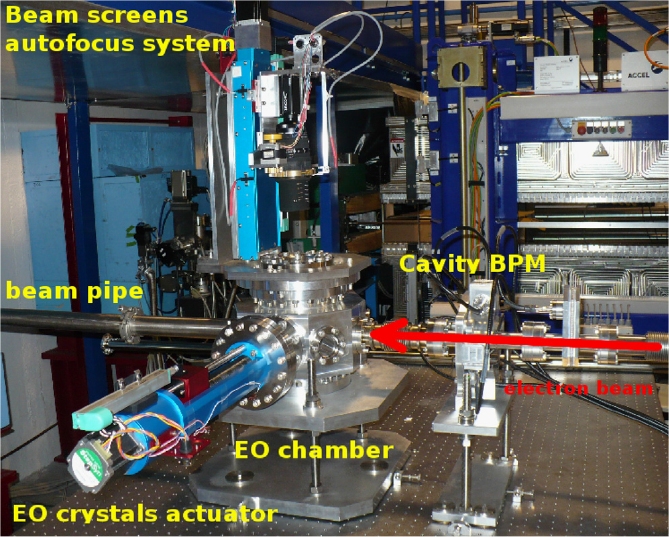
EOS experimental station. A cavity BPM is placed before the EOS chamber to monitor the bunch arrival time. The EOS chamber consists in two actuators, one for the EO crystals and the beam screens and the other to move the focus and the position of the top camera looking at these screens.
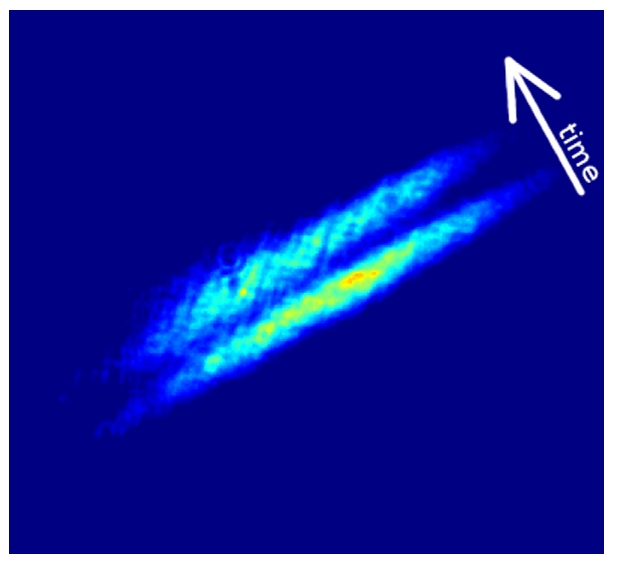
EOS single screenshot for the comb beam retrieved by using the 500 μm ZnTe crystal. The time direction is marked by the white arrow. The distance in time between bunches was about 920 fs.
EOS beam arrival time
The generation of ultra-short electron bunches with ultra-low timing-jitter relative to the photocathode laser has been experimentally proved exploiting a two-stage hybrid compression scheme. The first stage employs RF-based compression (velocity bunching), which shortens the bunch and imprints an energy chirp on it. The second stage is performed in a non-isochronous dogleg line, where the compression is completed resulting in a final bunch duration below 90 fs (rms). At the same time, the beam arrival timing-jitter with respect to the laser has been measured to be lower than 20 fs (rms) using the same setup of EOS but looking at the time of arrival.
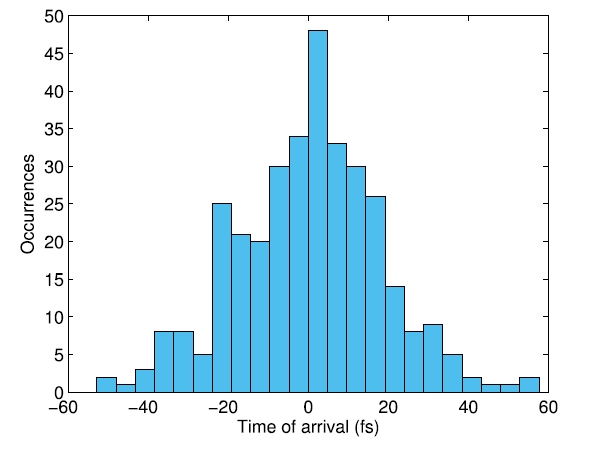
Collected time of arrival for 330 consecutive shots measured by the EOS. The resulting ATJ is about 20 fs rms.
EOS to probe the electric field
The interaction of a high-intensity short-pulse laser with thin solid targets generates jets of electrons that are emitted by the target and positively charge it, leading to the formation of the electrostatic potential that in turn governs the ion acceleration in the TNSA process. The typical timescale of such phenomena is on the subpicosecond level. So far only indirect evidences of the escaping electron component have been recorded but a detailed and time-resolved study of the release mechanism has not been carried out yet. We employed the Electro-Optical Sampling diagnostics also in this field with the goal to measure the energy and temporal evolution of the ejected electrons.
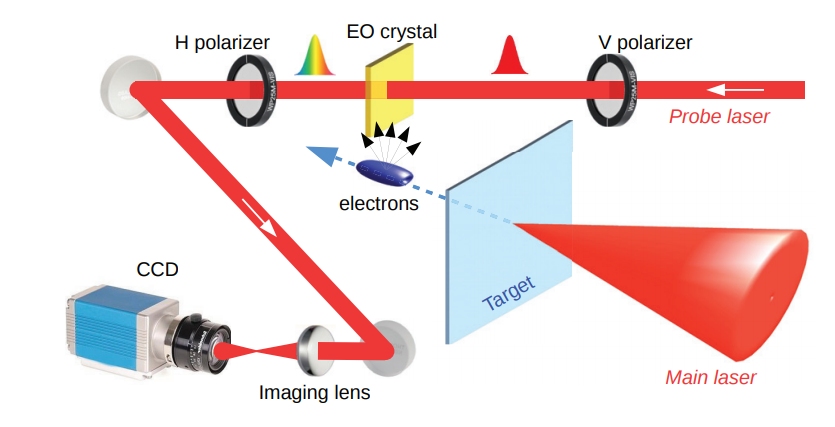
Setup of the experiment. The FLAME laser is focused on a metallic target that ejects electrons. The EOS diagnostics, based on a ZnTe crystal located 1 mm downstream the target, measures the temporal profile of the emitted electrons by means of an ultra-short probe laser.
We measured electron bunches up to 7 nC charge, ps duration and 12 MeV energy. Our “snapshots” capture their evolution with an unprecedented temporal resolution, demonstrating a significant boost in charge and energy of escaping electrons when increasing the geometrical target curvature. These results pave the way toward significant improvement in laser acceleration of ions using shaped targets allowing the future development of small scale laser-ion accelerators
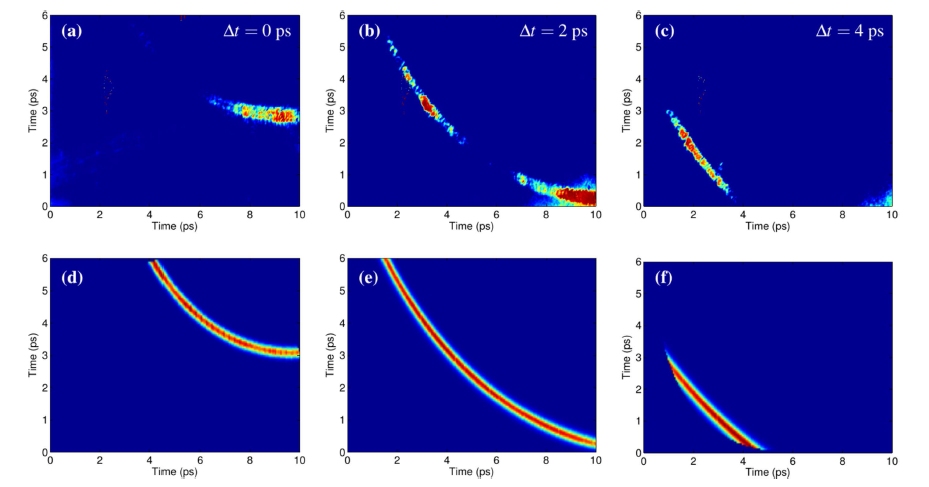
Snapshots with the wedged target. (a–c) Experimental measurements obtained by focusing the main laser on the edge of a wedged target at different probe laser delays (Δ t). The electron bunch is moving above the upper side of the crystal and normally to it. By measuring its time of flight we determined a mean energy of 15 MeV. The signal amplitude corresponds to 2.1 nC charge and the resulting bunch duration is 1 ps (rms). (d–f). Expected EOS signals assuming such bunch parameters. The lack of uniformity in the experimental signals, if compared with the simulated ones, is due to inhomogeneities in both the ZnTe crystal and probe laser spot.
Publication Highlights:
- “First single-shot and non-intercepting longitudinal bunch diagnostics for comb-like beam by means of electro-optic sampling”, R. Pompili et al., Nucl. Instrum. Meth. Phys. Res. A vol. 740 (2014) pag. 216-221, doi: 10.1016/j.nima.2013.10.031
- “Femtosecond timing-jitter between photo-cathode laser and ultra-short electron bunches by means of hybrid compression.”, R. Pompili et al., New J. Phys. vol. 18 n. 8 (2016) pag. 083033, doi: 10.1088/1367-2630/18/8/083033
- “Femtosecond dynamics of energetic electrons in high intensity laser-matter interactions”, R. Pompili et al., Sci. rep. vol. 6 (2016) pag. 35000, doi: 10.1038/srep35000
- “Ultrafast evolution of electric fields from high-intensity laser-matter interactions”, R. Pompili et al., Sci. rep. vol. 8 n. 1 (2018) pag. 3243, doi: 10.1038/s41598-018-21711-4
- “Direct visualization of relativistic Coulomb field in the near and far field ranges”, M. Galletti et al., New J. Phys. vol. 25 (2023) pag. 063014, doi: 10.1088/1367-2630/acdbe4
Beam diagnostics

